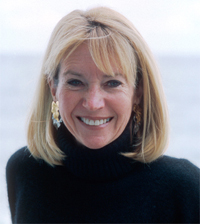 When Marcia
McNutt was a young child growing up in Minnesota, she would visit her grandmother
in La Jolla, Calif., every spring. “I can still remember the smell of the
ocean after getting off the plane in San Diego from Minnesota, the warm humid
air of March, the brilliant sunshine,” she says. “It was such a different
world.”
When Marcia
McNutt was a young child growing up in Minnesota, she would visit her grandmother
in La Jolla, Calif., every spring. “I can still remember the smell of the
ocean after getting off the plane in San Diego from Minnesota, the warm humid
air of March, the brilliant sunshine,” she says. “It was such a different
world.”McNutt is now intimately familiar with that world, as a geophysicist and oceanographer. The president and C.E.O. of the Monterey Bay Aquarium Research Institute (MBARI), McNutt has conducted geophysical research that has helped to elucidate Earth’s crustal dynamics, work for which she was elected a member of the National Academy of Sciences in May.
Marcia McNutt, president of the Monterey Bay Aquarium Research Institute, has been elected to the National Academy of Sciences for her scientific contributions to geophysics and understanding Earth’s crust. Image courtesy of MBARI.
McNutt says that as a teenager, before she became more sophisticated scientifically, she thought in black and white: “In my own naïve way, I equated science as being right or wrong,” she says.
This “quantitative bent” led her to science even in elementary school, and she knew she would major in physics when she started her undergraduate career at Colorado College in Colorado Springs in 1970. McNutt says that she had the good luck to land a spot reserved for incoming freshmen in introductory geology, a course that was to become one of the most popular at the school — and her first geology class, as the subject was not offered at the high school she attended.
John Lewis, the professor of the course, “had us roll up our sleeping bags” immediately and go out into the field to piece together the landscape’s history, “without opening a single book,” McNutt says. “I saw more Colorado geography than most people see their entire lives,” spending two months straight in the field as part of the college’s nontraditional “block” schedule.
Although she continued in physics, her freshman experience led her to pursue a science that would keep her outside. On approaching graduation in 1973, after only three years at Colorado College, McNutt was persuaded by her professor, Richard Hilt, to apply to graduate school — instead of going off to work as a housekeeper in a ski resort for a year, as she had planned.
“Students tell themselves these days, ‘oh I’m so burned out, I need to take a year off,’” Hilt says. “Marcia was never burned out; she was too busy burning up the track.” Hilt assigned McNutt to a reading course in geophysics, from which, she says, she got sucked into plate tectonics. Hilt says that as a student, McNutt “could see things quickly — she did the straightforward stuff just fine, and always had an extra burst of insight when she needed it.”
McNutt applied to graduate school at Scripps Institution of Oceanography, where she finished her Ph.D. in 1978. At that time, her cohort of geophysicists was interested in discovering the finer details of plate tectonics, which was still wide open, in places like the Arctic — but McNutt saw an opening for breaking ground in French Polynesia. She says that it was clear that “areas that couldn’t be explained by plate tectonics” provided a window of opportunity, she says, such as mid-plate volcanoes and oceanic hot spots (see Geotimes, April 2005).
In pursuing these topics, McNutt spent a year teaching in Minnesota, followed by several years of research on crustal stress for developing earthquake prediction at the U.S. Geological Survey in Menlo Park, Calif. McNutt says that Sean Solomon, now director of the Department of Terrestrial Magnetism at the Carnegie Institution of Washington, asked if she would consider joining his department at MIT, where she stayed for 15 years. She ultimately served as the director of the MIT and Woods Hole Oceanographic Institution joint program in oceanography, before heading to MBARI.
Her own time to do research is now limited, but she is excited to be involved in the interdisciplinary questions that MBARI has decided to pursue, from what will happen to ecosystems in an ocean that is absorbing “massive amounts of carbon dioxide at a rate that’s probably never been matched,” she says, to trying to understand the role of nitrogen, mixing and other ocean characteristics.
McNutt says that the experience that most prepared her for running MBARI would probably be raising her three daughters, two of whom are identical twins. “I’ve had to spend a lot of time listening to both sides and then trying to get the one to understand the position of her twin,” McNutt says. “It’s not ‘you’re right, you’re wrong,’” something that applies to bringing disparate views into synch for the execution of MBARI’s purposes as a research institution.
That experience may also have served her well while she was president of the American Geophysical Union from 2000 to 2002, and in the larger world of politics. She has appeared before Congress many times, most recently in April to testify (with Solomon and others) before the House Committee on Science regarding NASA’s responsibilities for earth observations.
“We as scientists don’t do enough to just mentor our own representatives and senators in Congress. It’s almost too bad that we have to do these public testimonies,” McNutt says. “We should be making a lot more appointments, holding their hands,” she says, to educate lawmakers about the impacts of their decisions.
Naomi Lubick
Links:
MBARI
"New dates defy fixed hotspots," Geotimes, April 2005
Back to top

